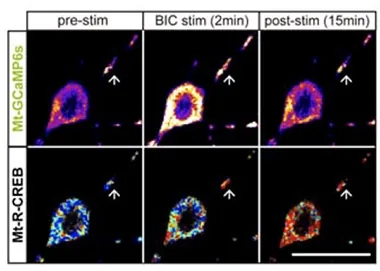
Unlocking the Secrets of Energy Supply in Neurons: How Mitochondria Respond to Neural Activity
2025-01-01
Author: Wei
In the dynamic world of neuroscience, recent studies reveal a powerful relationship between neuronal activity and mitochondrial function that could reshape our understanding of brain metabolism and aging. A groundbreaking study published in December 2023 by researchers from Zhejiang University School of Medicine, led by Huan Ma, explores how synaptic transmission—an energy-demanding process—gains its necessary ATP reserves through a newly discovered mechanism involving mitochondrial gene transcription.
As neurons respond to incoming signals, they rapidly engage ATP reserves, which serve as their energy currency. But how do these cells manage to keep up with the staggering demands posed by continuous synaptic transmission? The answer lies in a sophisticated coupling process between neuronal excitation and the transcription of genes located in mitochondrial DNA (mtDNA). When synaptic signals hit, they trigger a flood of calcium ions into the mitochondria, activating CREB—a transcription factor responsible for stimulating the expression of genes essential for oxidative phosphorylation, the process that generates ATP.
However, this efficient energy-supply mechanism deteriorates with age. Aging mice exhibited impaired coupling, leading to reduced neuronal energy reserves, weakened synaptic signaling, and memory deficits. The study emphasizes the critical role of mitochondria in adapting to neural demands and highlights their potential as targets for therapeutic intervention in age-related cognitive decline.
The researchers conducted comprehensive experiments to confirm this coupling. By employing both in vitro and in vivo approaches, they discovered that when young mice underwent a mild activation stimulus, such as a foot shock, their CA1 hippocampal neurons showed a surge in mitochondrial transcripts necessary for ATP production. In stark contrast, older mice did not exhibit the same response, as their ability to mobilize mitochondrial resources diminished significantly.
This discovery is akin to a bustling coffee shop where baristas must quickly ramp up production during peak hours—healthy mitochondria increase their output to meet neuronal demand. When this function breaks down, however, as observed in aging brains, it can lead to catastrophic results for cognitive function.
The team identified a calcium signaling mechanism that translates neuronal activity into mitochondrial transcription. By utilizing advanced imaging techniques, they demonstrated that in healthy neurons, calcium influx activates the mitochondrial calcium uniporter, facilitating calcium entry into the mitochondria. This increase in calcium not only fuels ATP production but also sparks synaptic activities that are crucial for learning and memory.
In a striking series of experiments, the researchers inhibited the CREB signaling pathway within mitochondria, ultimately reducing ATP production and impairing synaptic function. Neurons expressing this inhibitor struggled with memory tasks and failed to recognize previously encountered objects, underscoring the significance of the excitation-transcription coupling.
Remarkably, the researchers discovered that they could restore this mitochondrial function in older mice by introducing a constitutively active form of CREB targeted to mitochondria. This intervention not only revitalized mitochondrial transcription but also improved ATP levels and memory performance in these older subjects, suggesting potential pathways for combating age-related cognitive decline.
The implications of this research extend beyond understanding the aging process; they highlight a promising avenue for therapeutic strategies targeting mitochondrial function to maintain cognitive health as we age. As we uncover more about how neuronal activity influences mitochondrial responses, we edge closer to developing interventions that could slow down or even reverse cognitive impairment associated with aging.
In summary, the study's findings present a compelling narrative about the interplay between neuronal signaling and mitochondrial health. The research invites further exploration and emphasizes the vital role of mitochondria in sustaining neuronal function, paving the way for new strategies in battling cognitive decline as we age.
Stay tuned as more discoveries unfold in this thrilling intersection of neuroscience and cellular energy dynamics!
 Brasil (PT)
Brasil (PT)
 Canada (EN)
Canada (EN)
 Chile (ES)
Chile (ES)
 Česko (CS)
Česko (CS)
 대한민국 (KO)
대한민국 (KO)
 España (ES)
España (ES)
 France (FR)
France (FR)
 Hong Kong (EN)
Hong Kong (EN)
 Italia (IT)
Italia (IT)
 日本 (JA)
日本 (JA)
 Magyarország (HU)
Magyarország (HU)
 Norge (NO)
Norge (NO)
 Polska (PL)
Polska (PL)
 Schweiz (DE)
Schweiz (DE)
 Singapore (EN)
Singapore (EN)
 Sverige (SV)
Sverige (SV)
 Suomi (FI)
Suomi (FI)
 Türkiye (TR)
Türkiye (TR)
 الإمارات العربية المتحدة (AR)
الإمارات العربية المتحدة (AR)